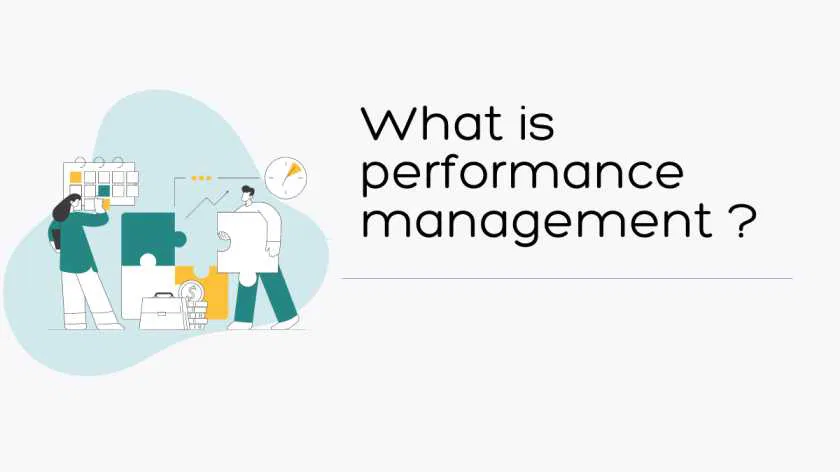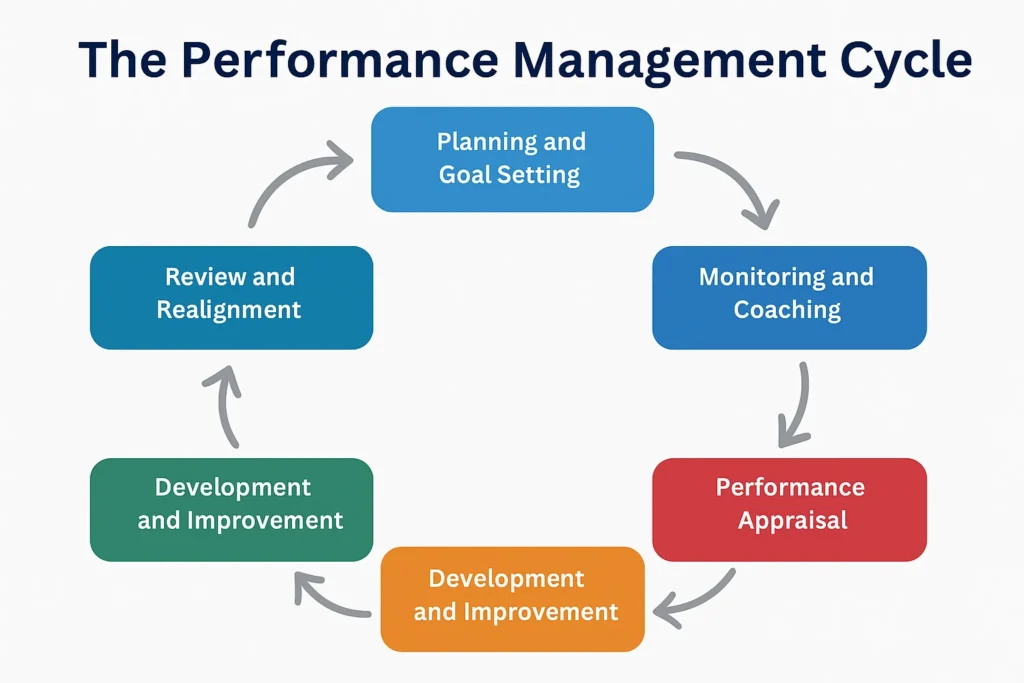
Executive Summary
Performance management (PM) is a systematic process organizations use to improve employee effectiveness, align individual goals with organizational objectives, and achieve sustainable business success. It encompasses setting expectations, monitoring progress, providing feedback, and fostering development.
Effective performance management ensures that employees understand their roles, have the necessary support to succeed, and are recognized for their contributions. It is not just a yearly review—it is an ongoing strategy that enhances productivity, engagement, and organizational growth.
This guide explores what performance management is, its components, processes, strategies, benefits, challenges, and trends, providing a comprehensive understanding for HR professionals, managers, and organizational leaders.
Table of Content
Introduction
In today’s competitive business environment, organizations rely on high-performing employees to maintain their edge. Performance management is the framework that ensures individuals contribute effectively to organizational goals.
PM is a continuous cycle of planning, monitoring, reviewing, and improving employee performance. It integrates performance appraisal, goal setting, coaching, feedback, and career development into a cohesive process. By linking individual performance to organizational objectives, it helps companies achieve strategic goals while nurturing employee growth and engagement.
Core Concepts of Performance Management
- Goal Alignment – Ensuring individual objectives support organizational strategy.
- Performance Planning – Defining expectations, KPIs, and success criteria.
- Monitoring and Feedback – Tracking progress and providing constructive feedback regularly.
- Performance Appraisal – Evaluating outcomes against objectives.
- Development and Coaching – Identifying skill gaps and enabling growth opportunities.
- Recognition and Reward – Motivating employees through acknowledgment of achievements.
- Continuous Improvement – Adapting processes based on performance outcomes.
Components of Performance Management
1. Goal Setting
- SMART Goals (Specific, Measurable, Achievable, Relevant, Time-bound) guide employees toward clear expectations.
- Goals should balance short-term deliverables and long-term development.
2. Performance Monitoring
- Continuous tracking of KPIs, milestones, and deliverables.
- Use of dashboards and reporting tools to identify trends and potential issues.
3. Feedback Mechanisms
- Real-time feedback enhances learning and engagement.
- Constructive feedback focuses on behaviors and results, not personal attributes.
4. Performance Appraisals
- Formal evaluations conducted quarterly, semi-annually, or annually.
- Often include self-assessment, manager evaluation, peer reviews, and 360-degree feedback.
5. Employee Development
- Identifying skill gaps and providing training or mentoring programs.
- Encouraging career growth and succession planning.
6. Recognition and Rewards
- Incentives such as promotions, bonuses, or public recognition.
- Motivates high performance and reinforces organizational values.
7. Documentation and Reporting
- Maintaining accurate performance records to inform decision-making.
- Supports compliance, compensation decisions, and career development.
The Performance Management Cycle
Performance management is a cyclical process rather than a one-time activity. The cycle typically includes the following stages:

1. Planning and Goal Setting
- Establish clear expectations and objectives aligned with organizational strategy.
- Identify key performance indicators (KPIs) and metrics to measure success.
2. Monitoring and Coaching
- Track ongoing progress and provide timely feedback.
- Identify challenges early and offer guidance or resources to overcome them.
3. Performance Appraisal
- Conduct structured evaluations to assess results against predefined goals.
- Incorporate multiple sources of feedback, including peers, subordinates, and self-assessment.
4. Development and Improvement
- Address skill gaps and enhance capabilities through training, mentoring, or workshops.
- Set new goals for continuous growth and performance enhancement.
5. Recognition and Reward
- Acknowledge achievements and reinforce behaviors that support organizational objectives.
- Utilize monetary, non-monetary, and intrinsic reward mechanisms.
6. Review and Realignment
- Analyze overall performance trends to refine goals, KPIs, and strategies.
- Ensure continuous alignment with evolving organizational priorities.
Benefits of Performance Management
- Enhanced Employee Productivity – Clear expectations and feedback drive focused efforts.
- Goal Alignment – Ensures individual contributions support organizational objectives.
- Increased Employee Engagement – Regular feedback and recognition improve morale.
- Identifies Training Needs – Helps target skill gaps and development opportunities.
- Supports Career Growth – Provides employees with structured growth pathways.
- Improved Decision-Making – Data-driven insights guide HR and management strategies.
- Retention of Top Talent – Engaged and recognized employees are more likely to stay.
- Promotes Continuous Improvement – Encourages learning from successes and failures.
- Optimizes Organizational Performance – Aligning people, processes, and goals drives strategic success.
Performance management closely aligns with several other key management systems that help organizations achieve efficiency, productivity, and long-term growth.
To understand how these concepts connect across business operations, explore these related guides:
- What Is Human Capital Management (HCM)? – Learn how managing and developing talent directly influences performance outcomes.
- What Is Business Management? – Discover how leadership, planning, and control drive high-performing organizations.
- What Is Operations Management? – Understand how optimizing processes enhances productivity and performance across teams.
- What Is Knowledge Management? – Explore how sharing expertise and information improves decision-making and results.
- What Is Time Management? – See how effective time use supports better individual and organizational performance.
Key Strategies in Performance Management
- SMART Goal Framework – Helps set specific, measurable, achievable, relevant, and time-bound objectives.
- 360-Degree Feedback – Collects input from multiple sources for a holistic assessment.
- Continuous Feedback Culture – Encourages open, frequent communication rather than just annual reviews.
- Balanced Scorecards – Integrates financial and non-financial performance metrics.
- Management by Objectives (MBO) – Focuses on achieving measurable goals collaboratively.
- Employee Development Plans – Individualized plans for skill enhancement and career growth.
- Recognition Programs – Aligns rewards with performance to motivate employees.
- Performance Analytics – Uses data to predict trends, identify gaps, and guide HR strategy.
- Integration with HR Technology – Tools and platforms streamline PM processes and reporting.
Tools and Technologies for Performance Management
- Performance Management Systems (PMS): SAP SuccessFactors, Workday, Oracle HCM, BambooHR
- Goal Tracking Tools: Asana, Monday.com, Trello for setting and tracking objectives
- Feedback Platforms: 15Five, Lattice, Culture Amp for continuous employee feedback
- Analytics Dashboards: Tableau, Power BI for monitoring KPIs and performance trends
- Learning and Development Platforms: LinkedIn Learning, Coursera for skill enhancement
- Employee Recognition Tools: Bonusly, Kudos for peer-to-peer and managerial recognition
Challenges in Performance Management

- Bias and Subjectivity – Personal preferences may influence evaluations.
- Infrequent Feedback – Annual reviews alone may not drive performance improvement.
- Goal Misalignment – Individual objectives not tied to organizational strategy can limit impact.
- Resistance to Change – Employees may perceive PM processes as punitive rather than developmental.
- Data Overload – Too much information without actionable insights can overwhelm managers.
- Inconsistent Standards – Variability in performance assessments across teams.
- Lack of Managerial Skills – Ineffective coaching and feedback delivery can reduce PM effectiveness.
Real-World Applications
- Corporate Businesses – Aligning individual and team goals with strategic objectives.
- Startups – Tracking performance in agile, fast-changing environments.
- Healthcare Organizations – Ensuring staff efficiency, patient care quality, and compliance.
- Educational Institutions – Monitoring faculty performance and student outcomes.
- Government Agencies – Enhancing accountability, service quality, and operational efficiency.
- Sales and Marketing Teams – Tracking KPIs such as revenue targets, conversions, and campaign effectiveness.
- Remote Workforce Management – Measuring productivity and engagement in distributed teams.
Key Metrics and KPIs
- Goal Achievement Rate – Percentage of objectives met by employees or teams.
- Employee Productivity – Output relative to effort or time invested.
- Engagement Score – Level of employee motivation and commitment.
- Training Completion Rate – Participation in development initiatives.
- Performance Improvement Rate – Change in performance over time.
- Feedback Utilization – How employees act on feedback and coaching.
- Retention of High Performers – Percentage of top talent retained over time.
- Balanced Scorecard Metrics – Combines financial, operational, customer, and learning metrics.
Common Misconceptions
- PM Is Only About Appraisals – It is a continuous process, not just an annual review.
- Performance Management Is Punitive – Its primary goal is development, improvement, and growth.
- Technology Alone Solves PM Issues – Tools support but cannot replace managerial guidance.
- One-Size-Fits-All Approach Works – PM must be tailored to individual roles, teams, and organizational culture.
- High Performance Equals High Productivity – Quality, impact, and alignment with goals matter more than output alone.
Emerging Trends in Performance Management
- Continuous Performance Management – Frequent check-ins, real-time feedback, and agile goal-setting.
- Employee Experience Focus – Emphasis on engagement, well-being, and motivation.
- Data-Driven Decision-Making – Leveraging analytics to inform performance strategies.
- AI and Predictive Analytics – Anticipating performance issues and optimizing talent management.
- Personalized Development Plans – Tailoring growth initiatives to individual learning styles and career paths.
- Recognition and Reward Gamification – Using game-like elements to incentivize achievement and engagement.
- Integration with Employee Wellness Programs – Linking performance management with mental health and well-being initiatives.
Conclusion
Performance management is a critical organizational practice that drives employee effectiveness, engagement, and alignment with strategic goals. By establishing clear objectives, monitoring progress, providing feedback, fostering development, and recognizing achievements, organizations create a high-performance culture that benefits both individuals and the enterprise.
In a rapidly evolving business landscape, continuous performance management, supported by technology, data insights, and a people-centric approach, ensures sustained organizational success, talent retention, and operational excellence.Executive Summary


